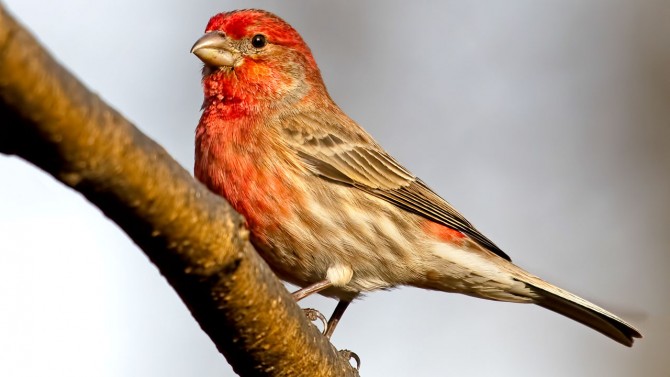Citizen science data tracks battle of birds vs. bacteria
By Pat Leonard
House finches are locked in a deadly cycle of immunity and new strains of bacterial infection in battling an eye disease that halved their population when it first emerged 25 years ago, according to new research from the Cornell Lab of Ornithology.
House finch eye disease causes red, swollen, watery or crusty eyes. Afflicted birds can recover, but may die because they cannot see well enough to find food or avoid predators. The latest analyses, based on the observations of Project FeederWatch participants from eight Northeast states, addresses the long-term impact of the disease on house finch populations and points to the role of the finch immune system in the bird vs. bacteria battle.
“We have an escalating arms race,” said Cornell Lab researcher Wesley Hochachka, first author of “Host Population Dynamics in the Face of an Evolving Pathogen,” which published April 5 in the Journal of Animal Ecology. “Finches who become infected but survive acquire some immunity to that version of the bacteria and its predecessors. The bacteria evolve to get around the strengthened finch immunity. Then birds acquire immunity to the latest strain, and the cycle keeps repeating.
The study’s authors believe that acquired immunity – when the immune system creates antibodies in response to an infection – is actually driving the arms race between the birds and the bacteria. They said imperfect acquired immunity, just like imperfect vaccines against human pathogens, creates the conditions needed to favor the proliferation of new strains of the bacteria that can overcome immunity acquired against existing strains of bacteria.
Immunity can also develop through genetic changes to the house finches, but this would be a relatively slow process, requiring multiple years for genetically novel and resistant finches to become widespread. In contrast, genetic changes to the bacteria can proliferate within hours – so fast that populations of house finches can’t possibly evolve a defense quickly enough.
“We should really pay more attention to the role that acquired immunity can play in the dynamics of disease in any animal,” Hochachka said. “Interactions can be much more complicated when both the host and the disease are able to change rapidly.”
The overall house finch population was cut in half during the initial outbreak when the bacteria jumped to finches from poultry in 1994. House finch populations now are mostly stable at their current, lower level.
Hochachka said that’s surprising because typically in other tracked animal diseases, either the animal populations rebound or fluctuate widely following the initial disease outbreak. But he thinks the finch population is not likely to return to pre-disease levels.
The finch eye disease dynamic has parallels to human health and the use of vaccines to give people acquired immunity to diseases. Here also, imperfect immunity – vaccines that do not provide perfect protection – are believed to accelerate the spread of new strains of pathogens against which vaccines are ineffective.
“The emergence of new diseases is going to keep happening,” Hochachka said. “We just have to develop methods and systems for dealing with it as best we can when a lethal disease appears.”
The research was partly supported by the National Science Foundation, the National Institutes of Health and the U.S. Department of Agriculture.
Pat Leonard is a staff writer at the Cornell Lab of Ornithology.
Media Contact
Get Cornell news delivered right to your inbox.
Subscribe

